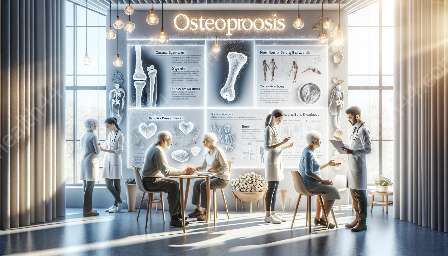Osteoporosis, a condition characterized by low bone density and increased risk of fractures, is a major public health concern, particularly among older adults. While it is well-established that lifestyle factors such as diet, exercise, and smoking can influence the development of osteoporosis, emerging evidence suggests that genetics also play a significant role in the risk of developing this condition.
In this article, we will explore the complex interplay between osteoporosis and genetics, and its implications for overall health. By delving into the genetic factors associated with osteoporosis, we can gain a deeper understanding of how this condition develops and how it may impact individuals' health.
The Role of Genetics in Osteoporosis
Genetics can influence various aspects of bone health, including bone mineral density (BMD), bone turnover, and the risk of fractures. Researchers have identified numerous genetic variants that are associated with an increased risk of osteoporosis. One of the key genetic determinants of BMD and osteoporosis risk is variations in the genes responsible for regulating bone formation and resorption.
For instance, specific genes involved in the production and function of collagen, a crucial component of bone tissue, can impact bone strength and resilience. Additionally, variations in genes related to the vitamin D receptor, which plays a vital role in calcium absorption and bone metabolism, have been linked to osteoporosis risk.
Furthermore, genetic factors may also influence an individual's response to osteoporosis treatments, such as medications aimed at improving bone density and reducing fracture risk. Understanding the genetic basis of osteoporosis can therefore have significant implications for personalized treatment and intervention strategies.
Genetic Testing for Osteoporosis Risk
Given the growing understanding of the genetic basis of osteoporosis, there has been increasing interest in using genetic testing to assess an individual's risk of developing this condition. Genetic testing can help identify specific genetic variants associated with increased osteoporosis risk, allowing for earlier intervention and personalized management strategies.
However, it is important to note that genetic testing for osteoporosis risk is still relatively nascent, and its clinical utility and cost-effectiveness are subjects of ongoing research and debate. While genetic testing may provide valuable insights into an individual's predisposition to osteoporosis, it is just one piece of the puzzle, and should be considered in conjunction with other risk factors and clinical assessments.
Genetics and Overall Health
Understanding the genetic underpinnings of osteoporosis not only enhances our knowledge of bone health but also has broader implications for overall health. Many of the genetic factors associated with osteoporosis risk are also linked to other health conditions, such as cardiovascular disease, diabetes, and certain cancers.
By identifying genetic predispositions to osteoporosis, healthcare providers may be better equipped to assess an individual's overall health risks and tailor preventative interventions accordingly. Moreover, genetic insights into osteoporosis may have implications for population health strategies, influencing policies related to bone health promotion and fracture prevention.
The Future of Genetics and Osteoporosis
As our understanding of the genetic basis of osteoporosis continues to evolve, it is likely that genetic information will play an increasingly prominent role in the prevention, diagnosis, and management of this condition. Efforts to unravel the complex genetic architecture of osteoporosis hold promise for the development of more targeted and effective therapies, paving the way for precision medicine approaches in bone health.
Additionally, ongoing research into the genetic determinants of osteoporosis may uncover novel pathways and therapeutic targets, opening new avenues for drug development and personalized treatment strategies. Collaborative efforts between geneticists, clinicians, and public health experts will be instrumental in harnessing the potential of genetics to mitigate the impact of osteoporosis on individuals and populations.
Conclusion
Osteoporosis is a multifactorial condition influenced by a complex interplay of genetic and environmental factors. While genetics alone do not determine an individual's risk of developing osteoporosis, they undoubtedly contribute to the overall susceptibility. Recognizing the role of genetics in osteoporosis allows for a more comprehensive understanding of this condition and its broader implications for health.
By leveraging genetic insights, healthcare providers can offer more personalized and targeted approaches to osteoporosis prevention and management, ultimately contributing to better health outcomes for individuals at risk of this debilitating condition.
Ongoing research into the genetic determinants of osteoporosis holds great promise for advancing our understanding of bone health and paving the way for innovative therapeutic strategies. Embracing the complexities of genetics in the context of osteoporosis is essential for optimizing preventative measures and improving the quality of life for those affected by this prevalent health condition.


